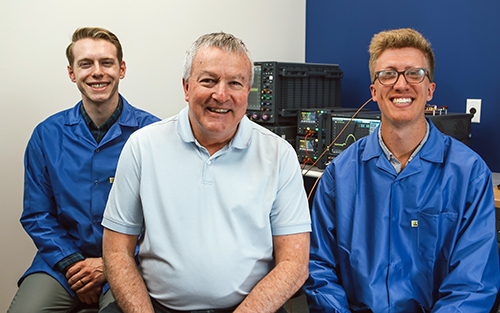By Leigh McLeod
Why go big when you can go small? For Radio Frequency (RF) Engineer Tim, that’s his modus operandi.
Tim joined Northrop Grumman in May 2021 to work on a classified program in Aurora, Colorado, but quickly realized he missed working on RF, which he’d spent most of his career on. When he heard Northrop Grumman was establishing an RF lab down the road in Boulder, Colorado, he jumped at the chance to run it.

Now, just one year after the lab was founded, Tim and his team — engineers Fletcher and Jonathan, who began supporting the lab part-time a few months ago — are conducting RF research with massive potential to transform satellite communications.
From Mud to Space
While Tim has worked in RF engineering for nearly 20 years, his career didn’t start out that way. The Denver native studied geophysical engineering and remote sensing at the Colorado School of Mines before earning his master’s degree in telecommunications engineering at the University of Colorado Boulder. He began his career in geophysics, first as a mud logger studying drilling mud produced on an offshore oil rig in Louisiana, and then gathering seismic data in the western United States.
“The data was collected in trucks with reel-to-reel tapes, then we’d drive the tapes to Denver,” Tim said. “I kept wondering why we weren’t uploading and downloading the data to a satellite. That’s when I said to myself, ‘I need to get into RF engineering.’”
This realization launched the next phase of Tim’s career, where he developed RF techniques for satellite communications and designed hardware to implement the communication.
Time to Downsize
The door of the RF lab is almost always open so Tim can excitedly share his leading-edge work with employees passing by.
One of Tim’s favorite things to discuss is direct RF conversion. RF downconverters are equipment that convert a high-frequency RF signal sent by a satellite into a lower intermediate frequency signal which is received by a ground station and used for missile warning and defense or secure communications. The RF downconverters currently on the market not only distort that signal by adding noise to it, but downconverter equipment is usually stored on a 10-by-3-foot server rack.
“I’m excited to miniaturize the capability of mobile downlink so that multiple antennas will fit into a pickup truck rather than in 30 semitrucks.”
— Tim, Radio Frequency Engineer
“I thought, ‘Why can’t we do this on a chip the size of your thumbnail?’” Tim said. “I was also discouraged that the speeds of the satellite downlinks were growing faster, yet downconverters were not keeping up. That limits our nation’s satellites from getting more information down to the ground for communications and intelligence.”
To address the shortcomings of current downconverters, Tim and his team are testing the feasibility of using a new analog-to-digital converter (ADC) which he expects will surpass current signal quality requirements and could be leveraged on the U.S. Space Force’s Spaced-Based Infrared System, a system that provides missile warning, missile defense and technical intelligence through satellites and ground-based systems. The reduction in size is incredible — the ADC is smaller than a penny, replacing a large rack with a 6-by-4-inch card — and early testing has shown the ADC has better than expected results, said Tim.
The Future is Small
Another example of bigger not being better is the RF lens antenna.Antennas for space-to-ground signals are often very large, about 10-to-20 meters in diameter, but Tim and his team are researching how to adapt new cellular technology to reduce antenna diameter to just 1 meter. If these smaller antennas can operate in the space-to-ground arena, Tim believes they will lower design and development costs while increasing mobility.
“I’m excited to miniaturize the capability of mobile downlink so that multiple antennas will fit into a pickup truck rather than in 30 semitrucks,” he said.
Tim’s cutting-edge research developments are being noticed; in addition to funding the lab, Northrop Grumman has provided independent research and development money for his projects.
“I enjoy being encouraged to develop ideas that are interesting and fun,” Tim said.
While Tim’s results may technically be small, his love of experimentation and passion for RF are helping him define possible for the future of satellite communications — and his ideas and dreams only continue to grow.


